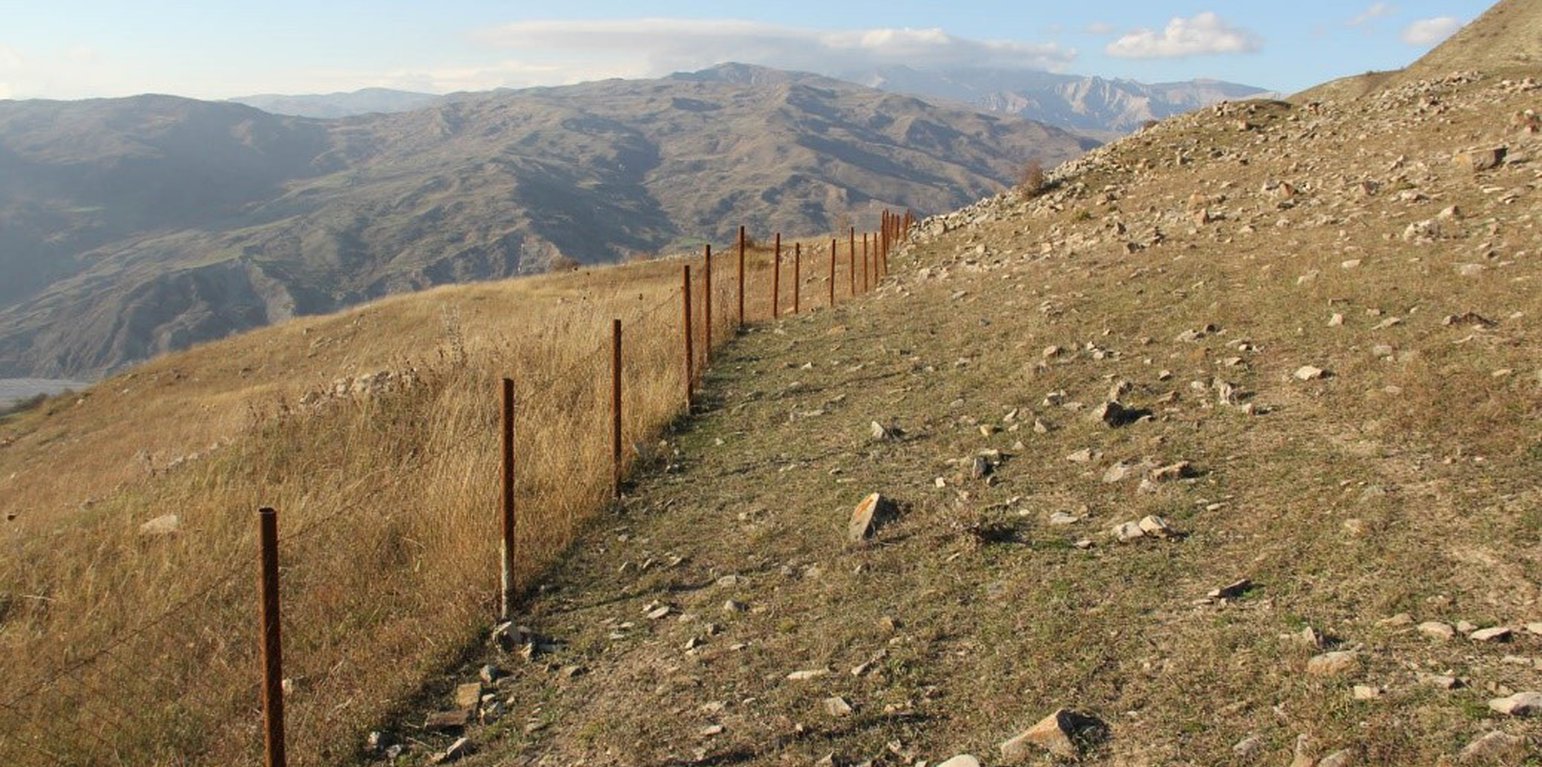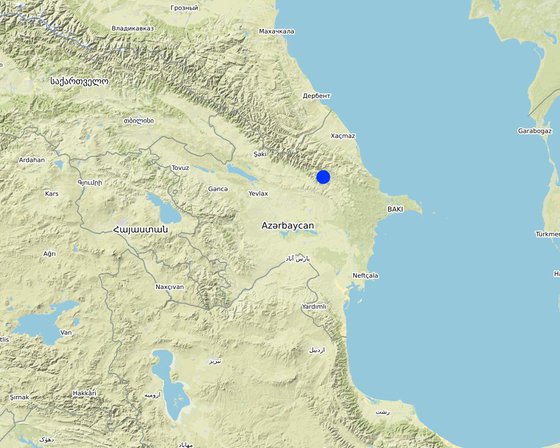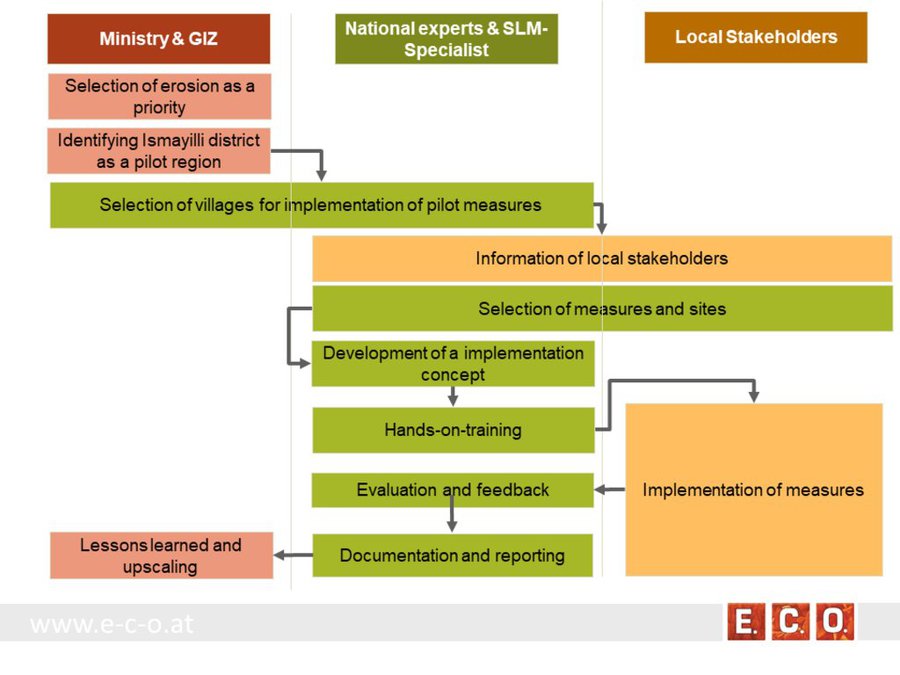



The Ministry of Ecology and Natural Resources of Azerbaijan togehter witht the Deutsche Gesellschaft fuer Zusammenarbeit (GIZ) selected integrated erosion control as a priority in their cooperation and the district Ismayilli was choosen for the implementation of pilot activities.
The district Ismayilli covers an area of about 2.158 km². Approximately 31% of the territory is covered with forest. Pasture lands on slopes are particularly exposed to vegetation degradation due to overgrazing. The loss of a closed vegetation cover on mountain slopes can lead to severe soil erosion due to surface water runoff. The project team together with the district administration decided to set the focus on the village Ehen near Lahic.
The approach chosen for integrated erosion control in Ehen was a community-based approach. Together with stakeholders, the most severe erosion sites were identified, and a list of priorities was developed. In cooperation with international experts, different technologies and practices were developed to stop erosion processes. Several preconditions for the development of a number of practices were set: The technologies should be cost-effective and affordable for the villagers, and the villagers should be able to use them without the use of external technicians. In order to achieve this, particular emphasis was placed on the application of bio-engineering measures. Measures were applied on degraded pasture lands and erosion gullies in the pilot community at the south slope of the Great Caucasus.
As a first step, the implementation sites were determined through joint field visits by village representatives and experts ('Screening mission'). In the first face the GIZ-team and the SLM-experts have been introduced to the village community. In this phase, the national GIZ project coordinator had the major role to create a basis of respect and trust to enable a positive athomisphere for an open minded discussion. The driving factors of deforestation and overgrazing were discussed in the field, and the potential intervention sites were marked with colour spray and wooden poles in the field. The marking in the field instead of only working with printed maps was very important for the recognition, discussion and acceptance of the sites by all villagers. There was a gap of several weeks between marking and implementation, which provided enough time for internal discussion about the site selection and the adaptation of boundaries.
Nine degraded pastures and forest land sites were selected by the village stakeholders togehter witht the SLM specialists. Four sites are located above the village with the risk of increasing rockfall and flooding by surface water runoff. Five sites are located below the village and were selected to ensure the productivity of the land. For providing tree seedlings, a local tree nursery was established near the school (10th site). One site was selected to combine effects by establishing a hazelnut plantation to stop erosion, increase vegetation cover and provide an income generation opportunity.
Two sites with gully erosion were selected: a site above the village with the risk of flooding into the village and a site below the village along the road with a high risk of road damage if the deepening process continues (detailed instructions on measures can be found at the internet links attached).
Regular meetings took place between the traditional administrative community board, the GIZ-project team and the SLM experts to discuss the implementation process and to evaluate together the results. The availability of local resources was taken into consideration to adapt technologies to fit the local needs. New ideas, localy available materials and technologies have beein integrated into the implementation process by the local stakeholders.
The implementation of the measures was done mainly by the local village people and local experts. The SLM experts provided 'hands-on-training' and all materials that were not available in the village as well external experts were financed by the project.
Another essential aspect is the sustainable use of well-managed meadows by different stakeholders (beekeepers, wild herb collectors, orchard owners and others) in the community. This includes the agreement (rule) of the community to share the protected pastures and to consider the needs of all interest groups. The decission of the profit sharing is taken by the taditional administrative community board. A further factor was the establishment of a tree nursery, which led to an increased motivation to plant additional trees (especially fruit trees) in the community.

الموقع: DIistrict Ismayilli, Ehen village, أذربيجان
تاريخ البدء: 2015
سنة الإنهاء: 2018
نوع النهج

| ما هي الجهات المعنية / الكيانات المنفذة التي شاركت في النهج؟ | حدد الأطراف المعنيين | وصف أدوار الأطراف المعنية |
| مستخدمو الأراضي المحليون/المجتمعات المحلية | Livestock farmers, shepherds, smallholder farms and women that were loosely organised. | Selection of sites for intervention, providing labour during implementation of measure, local hay residuals provided by farmers for testing the measure, maintenance of drip irrigation and electric fence of the hazelnut orchards. |
| متخصصون في الإدارة المستدامة للأراضي / مستشارون زراعيون | International and national specialists have been integrated. | The SLM specialist elaborated in close cooperation with the local stakeholders the implementation concept. |
| الباحثون | Researcher from the Agrarian University in Ganja. | |
| الحكومة المحلية | Ministry of Ecology and Natural Resources, Ismayilli District Administration | Numerous pilot activities (test and demonstrate the most appropriate actions and raise awareness of the community on the long-term socio- economic and environmental benefits of the pilot actions) have been implemented In cooperation with local government in Ehen municipality. |
This flow chart gives an overview on the different roles of project participants (Ministry and GIZ, the national experts and SLM specialists as well as the local stakeholders) and the actions implementented by them jointly or seperately.

وقد تم اتخاذ القرارات من قبل
تم اتخاذ القرارات بناء على
Construction of willow fascines, pill walls, wooden check dams, gabion check dams, tree planting, fence construction (electric fence, mesh wire fence), construction and maintenance of drip irrigation system.
Only the construction of technical infrastructure (fence, check dams, irrigation system was paid. Maintenance work was not paid.
Equipment (fence, water tanks, irrigation system, tools) have been financed. Seeds have been provided by locals.
Timber for pile walls was bought and provided, branches for willow fence and fascines was contributed by locals.
العمل من قبل مستخدمي الأراضي كان
For the implementation of the pilot measures in Ehen, material and payment for labour was provided. There have been some follow up activities in neighboring villages where only the material was provided, as the work was done voluntarily.
The application of easy-to-use measures for erosion control enabled local land users to arrange land management and erosion control measures by themselves without relying on significant external support. The pilot actions in the village Ehen are used as a showcase for the neighbouring villages.
As a result of the on-the-job training, most of the activities (fencing, pile walls, hay mulch application, wooden and gabion check dams) can now be implemented by the local village stakeholders without external support.
International funds were accessible for the village community and other international donors funded measures in the same village.
The involvement of local stakeholders in all stages of planning, site selection and implementation improved capacity and knowledge. It was very important that the work was done mainly by local village people and not by external companies.
University experts and district-level technicians participated in the planning and implementation. They can act as knowledge hubs.
Villagers have reported that the improved vegetation in the fenced areas led to significantly higher honey harvest and herb collection for marketing on the bazaar of Lahic village.
All gabions at the sites in Ehen are functioning well and show the impact of the gully deepening and the wash out at the lower (downhill) end of the gabion. Reduced water speed and the stabilised river bed helped to save the road.
Local stakeholders trained on building and applying measures. The measures (fencing, pile walls, wooden and gabion check dams) are low-cost and can easily be replicated by village stakeholders. Only the drip irrigation system and electric fencing for the hazelnut orchard needs high investment and might not be up-scaled without external support.